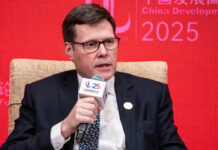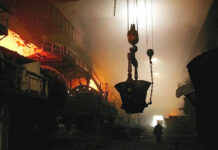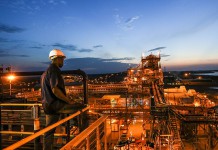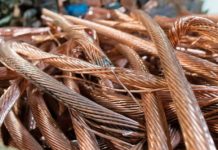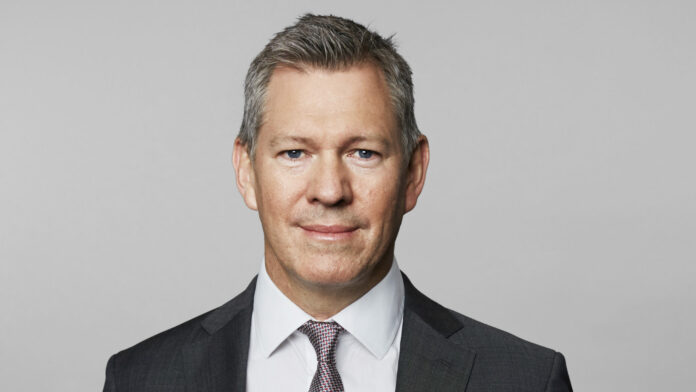
SO much for Africa’s largest gold mine, the sobriquet given to a joint venture (JV) in Ghana between Gold Fields and AngloGold Ashanti. Unveiled in March 2023, the aim was for the neighbouring Tarkwa and Iduapriem mines to share infrastructure, increase production to 900,000 ounces a year and cut costs.
More than two years later, AngloGold announced it was “pausing” the unconsummated arrangement. Publicly, it said Iduapriem might be better as a standalone mine after all. AngloGold CEO Alberto Calderon told analysts earlier this month that the gold price had very little to do with this decision. But there are reasons to doubt that.
When the JV was announced, gold was trading below $2,000/oz. Miners are now getting $1,335/oz more, a huge appreciation and one that potentially brings more of Iduapriem’s reserves and resources to the table.
Calderon said AngloGold is pursuing a strategy to expand the “horizons” of all its mines, Iduapriem included. But in the parlance of football beloved in Calderon’s native Colombia, “goals change games” — and the gold price is a spectacular score.
As for Gold Fields, CEO Mike Fraser still backs the “industrial logic” of the JV. “There are still opportunities to unlock a resource that is otherwise not accessible on a standalone basis,” he said in response to questions at the firm’s recent first quarter results announcement.
But for that to happen, the shape of the JV would need to be renegotiated, especially if AngloGold’s Iduapriem has a greater proportion of economic reserves to mine than Gold Fields’s Tarkwa. Now, AngloGold has a 30% share in the JV.
There’s also uncertainty as to how the Ghana government would finally participate in the JV. In terms of its original set-up in 2023, Ghana was to receive a 10% stake. But this was a shareholding to which the government never put its signature. Now that there’s a new administration in place after the December elections, the government may desire a larger stake to prove its electoral bona fides.
Testing for Gold Fields
As with so many things at Gold Fields, this is a testing dynamic in which Fraser has landed, rather than one he created. Appointed in 2024, he immediately walked into commissioning problems at Salares Norte, the firm’s $1.3bn Chile project. Based on Gold Fields’s first-quarter numbers, Fraser was able to strike a happier note on Salares Norte, which seems back on track for full commissioning by 2026, than for the AngloGold JV.
Before his arrival, Gold Fields had been without a permanently appointed CEO for nearly a year. Chris Griffith had stepped down, having failed to convince his shareholders to compete in a bidding war for Yamana Gold, a North American miner.
So Fraser deserves credit for making R70bn in two acquisitions the hallmark of his first 18 months, assuming they are both finally inked. One of these deals is Osisko Mining, a Canadian company that Gold Fields bought last year for C$2.16bn. The other is Gold Road Resources, a A$3.7bn deal unveiled this month.
Fraser succeeded where Griffith didn’t because Gold Fields was already the 50% partner with the underlying assets of both companies. (Buying Gold Road Resources, which is expected to be finalised in the second half of the year as it still requires shareholder approval, hands Gold Fields control over Gruyere in Western Australia.)
“We believe that buying a stake in an existing asset (Gruyere in this case) is the best type of M&A,” said Arnold van Graan, an analyst for Nedbank Securities.
“From that perspective, this deal should be positive,” he said, adding, however, that it “comes at a hefty premium”. Gold Fields’s offer represents a 43% premium to the Australian firm’s share price on March 21 before Gold Fields’s first bid, which was rejected amid notes of hostility.
Analysts at RMB Morgan Stanley added: “We view this acquisition as a lower-risk form of M&A — consolidating ownership of a lower-cost producing asset that Gold Fields already knows in a tier 1 mining jurisdiction.
“However, on the initial March 24 approach, we argued that Gold Fields was offering close to full value for the existing open-pit reserve at Gruyere. With [this] announcement Gold Fields has increased the cash consideration by 12% from the initial valuation.”
Gruyere growth
The gold price appreciated $200/oz between the two bids, but much of the justification for the premium rests on Gold Fields’s ability to extend Gruyere’s operating life through an expansion underground, through exploration at satellite deposits, and a possible further “cutback” of the existing open-pit mine. “There’s definitely an underground opportunity,” Fraser said.
“Our focus is much more about life extension on Gruyere than significant [production] growth. But it does provide an opportunity for incremental improvement. The simplification of decision-making is that we can control the timing of investment and how we draw the life extension in a sensible manner.” This is because Gruyere was Gold Road’s only cash-producing asset, so there was potential for it to think differently about the timing of reinvestment.
As Fraser said, sometimes the alignment between JV parties “isn’t always perfectly clear in terms of priorities of investment”. That much is clear from the JV with AngloGold.
A version of this article first appeared in the Financial Mail.


